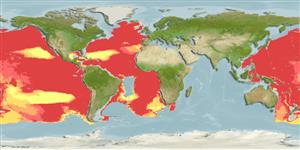Classification / Names
Common names | Synonyms | Catalog of Fishes(genus, species) | ITIS | CoL | WoRMS | Cloffa
Teleostei (teleosts) >
Lophiiformes (Anglerfishes) >
Himantolophidae (Footballfishes)
Etymology: Himantolophus: Greek, himas or himantos = leather strap, thong or leash (referring to the thick leathery illicium) + Greek, lopho or lophio = crest or tuft (referring to the baited illicium projecting from the head) (Ref. 86949).
Environment: milieu / climate zone / depth range / distribution range
Ecology
Marine; bathypelagic. Subtropical
Distribution
Countries | FAO areas | Ecosystems | Occurrences | Point map | Introductions | Faunafri
Widelspread: tropical and subtropical Atlantic and Pacific, including the Caribbean Sea and eastern Indonesian waters.
Size / Weight / Age
Maturity: Lm ? range ? - ? cm
Max length : 3.9 cm SL male/unsexed; (Ref. 86949)
Short description
Identification keys | Morphology | Morphometrics
Metamorphosed males of this species are distinguished from its congeners by the following characters: olfactory lamellae 14-17; greatest diameter of posterior nostril 3.5-6.4% SL; snout length 11-18% SL; 19-30 upper denticular teeth and 23-50 lower denticulat teeth (Ref. 86949).
Life cycle and mating behavior
Maturity | Reproduction | Spawning | Eggs | Fecundity | Larvae
Pietsch, T.W., 2009. Oceanic anglerfishes. Extraordinary diversity in the deep sea. Oceanic Anglerfishes, i-xii; 1-557pp. (Ref. 86949)
IUCN Red List Status (Ref. 130435: Version 2024-1)
Threat to humans
Harmless
Human uses
Tools
Special reports
Download XML
Internet sources
Estimates based on models
Phylogenetic diversity index (Ref.
82804): PD
50 = 0.5000 [Uniqueness, from 0.5 = low to 2.0 = high].
Bayesian length-weight: a=0.01995 (0.00906 - 0.04395), b=3.01 (2.83 - 3.19), in cm total length, based on all LWR estimates for this body shape (Ref.
93245).
Trophic level (Ref.
69278): 3.5 ±0.6 se; based on size and trophs of closest relatives
Fishing Vulnerability (Ref.
59153): Low vulnerability (10 of 100).
